Popular categories
Looking for a yarn?
Berry Delight
Knitted DROPS jumper with zig-zag pattern in ”Big Delight” and ”Vivaldi”. Size: S - XXXL.
DROPS design: Pattern no db-017
Yarn group C and C
-----------------------------------------------------------
Size: S/M - L/XL - XXL - XXXL
Finished measurements:
Bust: 108-122-136-148 cm / 42½"-48"-53½"-58"
Full length: 64-66-68-70 cm / 25¼"-26"-26¾"-27½"
Materials: DROPS BIG DELIGHT from Garnstudio
400-400-500-500 g color no 11, berry muffin
and use: DROPS VIVALDI from Garnstudio
150-150-150-150 g color no 01, black
DROPS CIRCULAR NEEDLE (40 and 80 cm / 16" and 32") SIZE 8 mm / US 11 - or size needed to get 10 sts x 14 rows in stockinette st with 1 strand of each yarn = 10 x 10 cm / 4" x 4" (one repetition of pattern measures 13.5-15-17-19 cm / 5¼"-6"-6¾"-7½" in width).
-------------------------------------------------------
Alternative Yarn – See how to change yarns here
Yarn Groups A to F – Use the same pattern and change the yarn here
Yarn usage using an alternative yarn – Use our yarn converter here
-------------------------------------------------------
- English (US/in)
- Česky
- Dansk
- Deutsch
- Eesti keel
- English (UK/cm)
- Español
- Français
- Íslenska
- Italiano
- Magyar
- Nederlands
- Norsk
- Polski
- Português
- Suomi
- Svenska
- English (UK/cm), Bulgaria
- English (UK/cm), Croatia
- English (UK/cm), Greece
- English (UK/cm), Latvia
- English (UK/cm), Lithuania
- English (UK/cm), Romania
- English (UK/cm), Slovenia
- Česky, Slovakia
Pattern instructions
K all rows. 1 ridge = K2 rows.
PATTERN:
See diagram A.1. Diagram shows all rows in pattern seen from RS. See diagram for size!
----------------------------------------------------------
BACK PIECE:
Worked back and forth on circular needle to make room for all the sts. Cast on 67-75-83-91 sts on circular needle size 8 mm / US 11 with one strand Big Delight and one strand Vivaldi. Work 2 RIDGES in garter st - see explanation above.
Then work as follows from RS: 1 edge st, A.1 over the next 64-72-80-88 sts, finish with 1 st in stockinette st and 1 edge st in garter st. Continue this pattern until piece measures 62-64-66-68 cm / 24½"-25¼"-26"-26¾".
Now bind off the middle 31-35-39-43 sts for neck = 18-20-22-24 sts remaining on each shoulder.
Finish each shoulder separately. Continue with A.1 until piece measures 64-66-68-70 cm / 25¼"-26"-26¾"-27½", bind off. Insert a marker in each side of back piece, 18-19-20-21 cm / 7"-7½"-8"-8¼" down from shoulder. This shows where sleeve is sewn in.
FRONT PIECE:
Cast on and work as on back piece until piece measures 58-60-61-63 cm / 22¾"-23½"-24"-24¾". Now slip the middle 23-27-31-35 sts on a stitch holder for neck and finish each shoulder separately.
Work in stockinette st over the sts that do not fit A.1. Then bind off on every row towards neck; 2 sts 1 time, 1 st 2 times = 18-20-22-24 sts remain on shoulder.
Continue with A.1 until piece measures 64-66-68-70 cm / 25¼"-26"-26¾"-27½", bind off.
Insert a marker in each side of front piece, 18-19-20-21 cm / 7"-7½"-8"-8¼" down from shoulder. This shows where sleeve is sewn in.
SLEEVE:
Worked back and forth on circular needle.
Cast on 26-28-30-32 sts (includes 1 edge st in each side) on needle size 8 mm / US 11 with one strand Big Delight and one strand Vivaldi.
Work 2 ridges in garter st, continue in stockinette st with 1 edge st in each side in garter st.
When piece measures 8 cm / 3", inc 1 st in each side. Repeat inc every 9-8-7½-6½ cm / 3½"-3⅛"-2⅞"-2½" 4 more times (5 inc in total) = 36-38-40-42 sts.
When piece measures 47-45-42-40 cm / 18½"-17¾"-16½"-15¾" (shorter measurements in the larger sizes because of wider shoulders), bind off all sts.
ASSEMBLY: Sew the shoulder seams. Sew in sleeves, down to markers. Sew underarm seams and side seams in one inside one edge st.
NECK EDGE:
Pick up 60-70 sts (includes sts on stitch holder) with one strand Big Delight and one strand Vivaldi on a short circular needle size 8 mm / US 11. Work 2 ridges in garter st, bind off.
Diagram
All measurements in charts are in cm.

|
= K from RS, P from WS |

|
= 1 YO between 2 sts |

|
= slip 1 st as if to K, K 2 tog, psso |

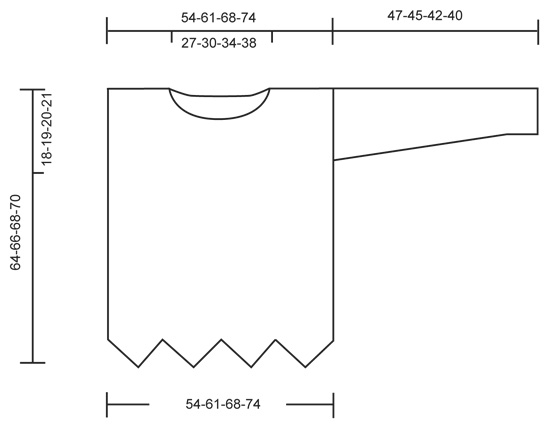
What can you do with our patterns? You can share DROPS patterns online, using the pattern original picture, materials, name and number. But you are NOT ALLOWED to reproduce the complete pattern digitally in any way. Yarn stores are welcome to use the DROPS pattern database to promote the sale of our assortment. You can print out our patterns, make as many copies as you’d like. The only thing we ask is that you don't make any changes / additions to the original printed document. And that the patterns according to the DROPS philosophy are given out to the consumers for free. Editorials that wish to publish our patterns in printed books or magazines can contact us for more information. The sale of garments based on DROPS patterns is permitted as long as they are sold as single items or per order. Further commercial use of the patterns is not permitted. It has to be clearly stated that the garment is made based on a design from DROPS DESIGN. The use of clothing labels of which DROPS DESIGN forms part is conditioned by the inclusion of the following text: “A DROPS DESIGN made by …..”. The use of DROPS photos for marketing purposes/sales is only permitted in connection with the use/sale of DROPS products. The photos may not be cut or edited and the logo should be clearly visible.
We reserve the right to withdraw the permission for use of our patterns at any time, notwithstanding the reason.
Each of our patterns has specific tutorial videos to help you.
These step-by-step tutorials might also help you:
Why is the knitting/crochet tension so important?
Knitting tension is what determines the final measurements of your work, and is usually measured per 10 x 10 cm. It is provided like so: number of stitches in width x number of rows in height - eg: 19 stitches x 26 rows = 10 x 10 cm.
The knitting tension is very individual; some people knit/crochet loosely while others work tightly. You adjust the knitting tension with the needle size, which is why the suggested needle size only serve as a guide! You need to adjust this (up or down) to ensure that YOUR knitting tension matches the knitting tension provided in the pattern. If you work with a different knitting tension than provided you will have a different yarn consumption, and your work will have different measurements than what the pattern suggests.
The knitting tension also determines which yarns can replace each other. As long as you achieve the same knitting tension you can replace one yarn with another.
See DROPS lesson: How to measure your tension/gauge
See DROPS video: How to make a gauge tension swatch
How do I know how many balls of yarn I need?
The required amount of yarn is provided in grams, eg: 450 g. To calculate how many balls you’ll need you first need to know how many grams are in 1 ball (25g, 50g or 100g). This information is available if you click on the individual yarn quality on our pages. Divide the amount required with the amount of each ball. For example, if each ball is 50g (the most common amount), the calculation will be as follows: 450 / 50 = 9 balls.
Can I use a different yarn than what the pattern suggests?
The important thing when changing from one yarn to another is that the knitting/crochet tension remains the same. This is so that the measurements of the finished piece will be the same as on the sketch provided. It is easier to achieve the same knitting tension using yarns from the same yarn group. It is also possible to work with multiple strands of a thinner yarn to achieve the knitting tension of a thicker one. Please try our yarn converter. We recommend you to always work a test swatch.
Please NOTE: when changing yarn the garment might have a different look and feel to the garment in the photo, due to individual properties and qualities of each yarn.
See DROPS lesson: Can I use a different yarn than the one mentioned in the pattern?
What are the yarn groups?
All our yarns are categorised into yarn groups (from A to F) according to thickness and knitting tension – group A contains the thinnest yarns and group F the thickest. This makes it easier for you to find alternative yarns to our patterns, should you wish to switch yarn. All yarns within the same group have a similar knitting tension and can easily replace each other. However, different yarn qualities have different structures and properties which will give the finished work a unique look and feel.
How do I use the yarn converter?
At the top of all our patterns you’ll find a link to our yarn converter, which is a helpful tool should you wish to use a different yarn than suggested. By filling in the yarn quality you wish to replace, the amount (in your size) and number of strands, the converter will present good alternative yarns with the same knitting tension. Additionally it will tell you how much you’ll require in the new qualities and whether you’ll need to work with multiple strands. Most skeins are 50g (some are 25g or 100g).
If the pattern is worked with multiple colours, every colour will have to be converted separately. Similarly, if the pattern is worked with several strands of different yarns (for example 1 strand Alpaca and 1 strand Kid-Silk) you will have to find alternatives for each, individually.
Why do you show discontinued yarns in the patterns?
Since different yarns have different qualities and textures we have chosen to keep the original yarn in our patterns. However, you can easily find options among our available qualities by using our yarn converter, or simply pick a yarn from the same yarn group.
It is possible that some retailers still have discontinued yarns in stock, or that someone has a few skeins at home that they would like to find patterns for.
The yarn converter will provide both alternative yarn as well as required amount in the new quality.
What size should I knit?
If you think it's hard to decide what size to make, it can be a good idea to measure a garment you own already and like the size of. Then you can pick the size by comparing those measures with the ones available in the pattern's size chart.
You'll find the size chart at the bottom of the pattern.
See DROPS lesson: How to read size chart
Why do I get the wrong knitting tension with the suggested needle size?
The needle size provided in the pattern serves only as a guide, the important thing is to follow the knitting tension. And since knitting tension is very individual, you will have to adjust the needle size to ensure that YOUR tension is the same as in the pattern – maybe you’ll have to adjust 1, or even 2 needle sizes, up or down to achieve the correct tension. For this, we recommend that you work test swatches.
Should you work with a different knitting tension than the one provided, the measurements of the finished garment might deviate from the measurement sketch.
See DROPS lesson: How to measure your tension/gauge
See DROPS video: How to make a gauge tension swatch
Why is the pattern worked top-down?
Working a garment top-down provides more flexibility and room for personal adjustment. For example it is easier to try the garment on while working, as well as making adjustments to length of yoke and shoulder caps.
The instructions are carefully explaining every step, in the correct order. Diagrams are adjusted to the knitting direction and are worked as usual.
How do I work according to a knitting diagram?
The diagram depicts all rows/rounds, and every stitch seen from the right side. It is read from bottom to top, from right to left. 1 square = 1 stitch.
When working back and forth, every other row is worked from the right side and every other row is worked from the wrong side. When working from the wrong side, the diagram will have to be worked reversed: from left to right, knit stitches are purled, purl stitches are knit etc.
When working in the round every round is worked from the right side and the diagram are worked from right to left on all rounds.
See DROPS lesson: How to read knitting diagrams
How do I work according to a crochet diagram?
The diagram depicts all rows/rounds, and every stitch seen from the right side. It is worked from bottom to top, from right to left.
When working back and forth every other row is worked from the right side: from right to left and every other row is worked from the wrong side: from left to right.
When working in the round, every row in the diagram are worked from the right side, from right to left.
When working a circular diagram you start in the middle and work your way outwards, counter clockwise, row by row.
The rows usually start with a given number of chain stitches (equivalent to the height of the following stitch), this will either be depicted in the diagram or explained in the pattern.
See DROPS lesson: How to read crochet diagrams
How do I work several diagrams simultaneously on the same row/round?
Instructions for working several diagrams after each other on the same row/round, will often be written like so: “work A.1, A.2, A.3 a total of 0-0-2-3-4 times". This means you work A.1 once, then A.2 is worked once, and A.3 is repeated (in width) the number of times provided for your size – in this case like so: S = 0 times, M = 0 times, L=2 times, XL= 3 times and XXL = 4 times.
The diagrams are worked as usual: begin with the first row in A.1, then work the first row in A.2 etc.
See DROPS lesson: How to read knitting diagrams
See DROPS lesson: How to read crochet diagrams
Why are the sleeves shorter in larger sizes?
The total width of the garment (from wrist-to-wrist) will be larger in the larger sizes, despite the actual sleeves being shorter. The larger sizes have longer sleeve caps and wider shoulders, so there will be a good fit in all sizes.
Where on the garment is the length measured?
The measurement sketch/schematic drawing provides information regarding the full length of the garment. If it’s a jumper or a jacket the length is measured from the highest point on the shoulder (usually closest to the neckline), and straight down to the bottom of the garment. It is NOT measured from the tip of shoulder. Similarly, the length of yoke is measured from the highest point on the shoulder and down to where yoke is split into body and sleeves.
See DROPS lesson: How to read a schematic drawing
What is a repeat?
Diagrams are often repeated on the round or in height. 1 repeat is the diagram the way it appears in the pattern. If it says to work 5 repeats of A.1 in the round, then you work A.1 a total of 5 times after/next to each other in the round. If it says to work 2 repeats of A.1 vertically/in height you work the entire diagram once, then begin again at the start and work the entire diagram one more time.
Why does the piece start with more chain stitches than it’s worked with?
Chain stitches are slightly narrower than other stitches and to avoid working the cast-on edge too tight, we simply chain more stitches to begin with. The stitch count will be adjusted on the following row to fit the pattern and measurement sketch.
Why increase before the rib edge when the piece is worked top-down?
The rib edge is more elastic and will contract slightly compared to, for example, stocking stitch. By increasing before the rib edge, you avoid a visible difference in width between the rib edge and the rest of the body.
Why increase in the cast-off edge?
It’s very easy to cast off too tightly, and by making yarn overs while casting off (and simultaneously casting these off) you avoid a too tight cast off edge.
See DROPS video: How to bind off with yarn overs (yo)
How do I increase/decrease on every 3rd and 4th row/round alternately?
To achieve an even increase (or decrease) you can increase on, for example: every 3rd and 4th row alternately, like so: work 2 rows and increase on the 3rd row, work 3 rows and increase on the 4th. Repeat this until the increase is complete.
See DROPS lesson: Increase or decrease 1 st on every 3rd and 4th row alternately
How can I work a jacket in the round instead of back and forth?
Should you prefer to work in the round instead of back and forth, you may of course adjust the pattern. You’ll need to add steeks mid-front (usually 5 stitches), and follow the instructions. When you would normally turn and work from the wrong side, simply work across the steek and continue in the round. At the end you’ll cut the piece open, pick up stitches to work bands, and cover the cut edges.
See DROPS video: How to knit steeks and cut open
Can I work a jumper back and forth instead of in the round?
Should you prefer to work back and forth instead of in the round, you may of course adjust the pattern so you work the pieces separately and then assemble them at the end. Divide the stitches for the body in 2, add 1 edge stitch in each side (for sewing) and work the front and back pieces separately.
See DROPS lesson: Can I adapt a pattern for circular needles into straight needles?
Why is the pattern slightly different than what I see in the photo?
Pattern repeats can vary slightly in the different sizes, in order to get the correct proportions. If you’re not working the exact same size as the garment in the photo, yours might deviate slightly. This has been carefully developed and adjusted so that the complete impression of the garment is the same in all sizes.
Make sure to follow instructions and diagrams for your size!
How do I make a women’s size garment into a men’s size one?
If you have found a pattern you like which is available in women’s size it’s not very difficult to convert it to men’s size. The biggest difference will be the length of sleeves and body. Start working on the women size that you think would fit across the chest. The additional length will be worked right before you cast off for the armhole/sleeve cap. If the pattern is worked top-down you can add the length right after the armhole or before the first decrease on sleeve.
Regarding additional yarn amount, this will depend on how much length you add, but it is better with a skein too many than too few.
How do I prevent a hairy garment from shedding?
All yarns will have excess fibres (from production) that might come off as lint or shedding. Brushed yarns (ie hairier yarns) have more of these loose, excess fibres, causing more shedding.
Shedding also depends on what is worn under or over the garment, and whether this pulls at the yarn fibres. It’s therefore not possible to guarantee that there will be no shedding
Below are some tips on how to get the best result when working with hairier yarns:
1. When the garment is finished (before you wash it) shake it vigorously so the looser hairs come off. NOTE: do NOT use a lint roller, brush or any method that pulls at the yarn.
2. Place the garment in a plastic bag and put it in your freezer - the temperature will cause the fibres to become less attached to each other, and excess fibres will come off easier.
3. Leave in the freezer for a few hours before taking it out and shaking it again.
4. Wash the garment according to the instructions on the yarn label.
Why does my garment pill?
Pilling is a natural process that happens to even the most exclusive of fibers. It's a natural sign of wear and tear that is hard to avoid, and that is most visible in high friction areas of your garment like a sweater's arms and cuffs.
You can make your garment look as new by removing the pilling, using a fabric comb or a pill/lint remover.
In the meantime, you can read the questions and answers that others have left to this pattern or join the DROPS Workshop on Facebook to get help from fellow knitters/crocheters!
You might also like...
Berry Delight |
||||||||||
|
|
||||||||||
Knitted DROPS jumper with zig-zag pattern in ”Big Delight” and ”Vivaldi”. Size: S - XXXL.
DROPS 150-32 |
||||||||||
|
GARTER ST (back and forth on needle): K all rows. 1 ridge = K2 rows. PATTERN: See diagram A.1. Diagram shows all rows in pattern seen from RS. See diagram for size! ---------------------------------------------------------- BACK PIECE: Worked back and forth on circular needle to make room for all the sts. Cast on 67-75-83-91 sts on circular needle size 8 mm / US 11 with one strand Big Delight and one strand Vivaldi. Work 2 RIDGES in garter st - see explanation above. Then work as follows from RS: 1 edge st, A.1 over the next 64-72-80-88 sts, finish with 1 st in stockinette st and 1 edge st in garter st. Continue this pattern until piece measures 62-64-66-68 cm / 24½"-25¼"-26"-26¾". Now bind off the middle 31-35-39-43 sts for neck = 18-20-22-24 sts remaining on each shoulder. Finish each shoulder separately. Continue with A.1 until piece measures 64-66-68-70 cm / 25¼"-26"-26¾"-27½", bind off. Insert a marker in each side of back piece, 18-19-20-21 cm / 7"-7½"-8"-8¼" down from shoulder. This shows where sleeve is sewn in. FRONT PIECE: Cast on and work as on back piece until piece measures 58-60-61-63 cm / 22¾"-23½"-24"-24¾". Now slip the middle 23-27-31-35 sts on a stitch holder for neck and finish each shoulder separately. Work in stockinette st over the sts that do not fit A.1. Then bind off on every row towards neck; 2 sts 1 time, 1 st 2 times = 18-20-22-24 sts remain on shoulder. Continue with A.1 until piece measures 64-66-68-70 cm / 25¼"-26"-26¾"-27½", bind off. Insert a marker in each side of front piece, 18-19-20-21 cm / 7"-7½"-8"-8¼" down from shoulder. This shows where sleeve is sewn in. SLEEVE: Worked back and forth on circular needle. Cast on 26-28-30-32 sts (includes 1 edge st in each side) on needle size 8 mm / US 11 with one strand Big Delight and one strand Vivaldi. Work 2 ridges in garter st, continue in stockinette st with 1 edge st in each side in garter st. When piece measures 8 cm / 3", inc 1 st in each side. Repeat inc every 9-8-7½-6½ cm / 3½"-3⅛"-2⅞"-2½" 4 more times (5 inc in total) = 36-38-40-42 sts. When piece measures 47-45-42-40 cm / 18½"-17¾"-16½"-15¾" (shorter measurements in the larger sizes because of wider shoulders), bind off all sts. ASSEMBLY: Sew the shoulder seams. Sew in sleeves, down to markers. Sew underarm seams and side seams in one inside one edge st. NECK EDGE: Pick up 60-70 sts (includes sts on stitch holder) with one strand Big Delight and one strand Vivaldi on a short circular needle size 8 mm / US 11. Work 2 ridges in garter st, bind off. |
||||||||||
Diagram explanations |
||||||||||
|
||||||||||

|
||||||||||

|
||||||||||
|
Have you made this or any other of our designs? Tag your pictures in social media with #dropsdesign so we can see them! Do you need help with this pattern?You'll find tutorial videos, a Comments/Questions area and more by visiting the pattern on garnstudio.com. © 1982-2024 DROPS Design A/S. We reserve all rights. This document, including all its sub-sections, has copyrights. Read more about what you can do with our patterns at the bottom of each pattern on our site. |
||||||||||
With over 40 years in knitting and crochet design, DROPS Design offers one of the most extensive collections of free patterns on the internet - translated to 17 languages. As of today we count 304 catalogs and 11422 patterns - 11417 of which are translated into English (US/in).
We work hard to bring you the best knitting and crochet have to offer, inspiration and advice as well as great quality yarns at incredible prices! Would you like to use our patterns for other than personal use? You can read what you are allowed to do in the Copyright text at the bottom of all our patterns. Happy crafting!













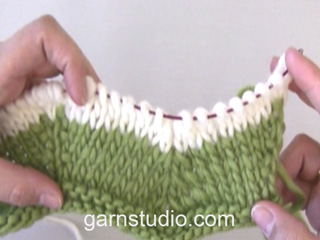


















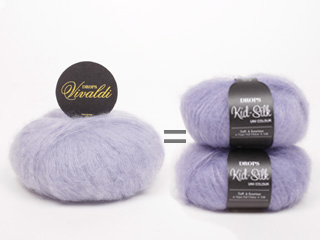

















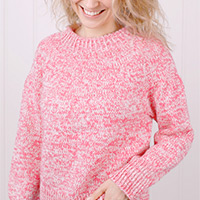
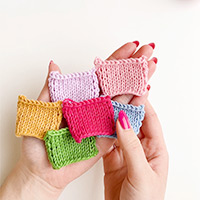

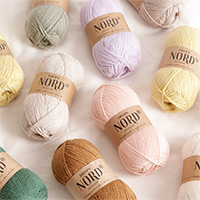
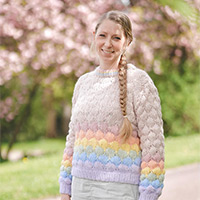
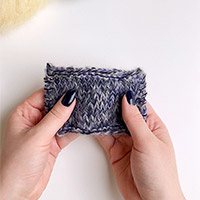
Comments / Questions (59)
Se realizzo il modello senza il filo di vivaldi, o meglio del suo sostituto, quindi usando solo il big delight, l'effetto è molto diverso dall'originale? Devo usare un numero di ferri diverso? Grazie
01.02.2019 - 20:56DROPS Design answered:
Buongiorno Francesca. Con solo il big delight dovrà lavorare con ferri più piccoli e controllare anche il numero delle maglie. Risalterà di più la sfumatura del filato. Per ogni aiuto personalizzato, può rivolgersi al suo rivenditore Drops di fiducia. Buon lavoro!
02.02.2019 - 08:29Hello! I'm hoping to start this pattern this weekend. Please can you explain why you advise using circular needles. How would this work? Since the back and front are knitted separately with a side seam to join them, could I use straight needles? I am a little confused. Thank you.
01.07.2017 - 14:44DROPS Design answered:
Dear Margaret, we recommend using circular needles in this pattern to have enough room for all the stitches and work more comfortably. If you don't have these problems with the straight needles, you may use them as well.
01.07.2017 - 19:34Pour information, j'ai remplacé Vivaldi par Brushed Alpaca Silk, et 125 grammes sont nécessaires donc 5 pelotes.
31.03.2017 - 11:53The pattern talks about PSSO. Is this a 1 stitch decrease or 2 stitch decrease. I've seen PSSOs done both ways. Thanks
16.03.2017 - 19:12DROPS Design answered:
Dear Mrs Haydsen, the video below shows how to slip 1, k2 tog, psso. Happy knitting!
17.03.2017 - 08:35Dans le patron on lit :Continuer ensuite ainsi sur l'endroit: 1 m lis, A.1 au-dessus des 64-72-80-88 m suiv, terminer par 1 m en jersey end et 1 m lis au point mousse. Ne devrait on pas lire : Continuer ainsi sur l'endroit 1 m lis 1 m jersey end A.1 au-dessus des 64-72-80-88 m suiv ??
05.03.2017 - 16:07DROPS Design answered:
Bonjour Mme St-Onge, on répète d'abord A.1 et on termine par 1 m jersey end: A.1 se commence par 1 m end, puis 1 jeté etc. et se termine par 1 jeté. Pour que le motif soit identique des 2 côtés, on va donc terminer le rang par 1 m end après le dernier A.1, on a ainsi 1 m jersey end en début et en fin de rang, à 1 m lis des bords. Bon tricot!
06.03.2017 - 09:52Hi Sorry forgot to ask the sizing as it only states s - XXXL Would you be able to let me know THank you
17.02.2017 - 15:20DROPS Design answered:
Dear Angela, you will find a measurement chart at the bottom of the page, with all measurements for each size in cm taken flat from side to side. Compare these to a similar garment you have and like the shape to find out the matching size. Read more here. Happy knitting!
17.02.2017 - 16:17Hi I am hoping to start this jumper soon but notice i only need 150g of the second wool do you not knit the entire jumper in both strands?
16.02.2017 - 09:02DROPS Design answered:
Dear Angela, you are working throughout with 2 qualities, and require same meterage in both yarn - please note that Vivaldi is discontinued, but you can replace it with Brushed Alpaca Silk or 2 strands Kid-Silk, read more here. Happy knitting!
16.02.2017 - 09:46Wil de trui graag breien met fabel longprint dubb. draad ipv big delight is dat mogelijk?
03.02.2017 - 18:30DROPS Design answered:
Hoi Cilia. Ja, dat kan zeker, maar vergeet niet om een proeflapje te breien zodat je stekenverhouding correct is.
06.02.2017 - 13:29Bonjour, Je voudrais réaliser ce pull en Bomul lin. Dois-je le tricoter en double ? Merci d'avance pour votre réponse.
04.11.2016 - 16:26DROPS Design answered:
Bonjour Chantal, Bomull-Lin est effectivement du groupe C comme Big Delight et Vivaldi, toutefois Vivaldi se remplacerait plutôt par Brushed Alpaca Silk pour conserver le même type de fil. Vous trouverez plus d'infos ici, et votre magasin DROPS saura vous conseiller judicieusement. Bon tricot!
07.11.2016 - 08:36Ich möchte diesen schönen Pullover stricken. Mich verwirrt die Mengenangabe. Als Alternative zu Vivaldi habe ich big merino (Garngruppe C ist angegeben) gekauft - 150g. Aber 400g Big Delight. Wenn ich nun beide Garne anschlage und verstricke, ist doch Big Merino bald leer? Es wird doch der gesamte Pullover mit beiden Garnen gestrickt, oder habe ich das falsch verstanden? Vielen Dank! Beatrice
27.06.2016 - 10:09DROPS Design answered:
Liebe Beatrice, ja, das geht nicht auf, denn Vivaldi hatte eine ganz andere Lauflange als Big Merino, auch wenn sie zu der gleichen Garngruppe gehören (Sie finden diese Angabe unter «Auslaufgarne»): Vivaldi= 280 m / 50 g und Big Merino= 75 m/100 g. Von Big Delight verstricken Sie 4 x 100 g, also 4 x 190 m, also brauchen Sie 760 m, das entspricht 11 Knäuel Big Merino. Ich würde Ihnen allerdings empfehlen, die Vivaldi durch Brushed Alpaca Silk zu ersetzen, dies entspricht eher dem Charakter des Originalmaterials. Von diesem Garn benötigen Sie 6 Knäuel à 25 g.
06.07.2016 - 09:23